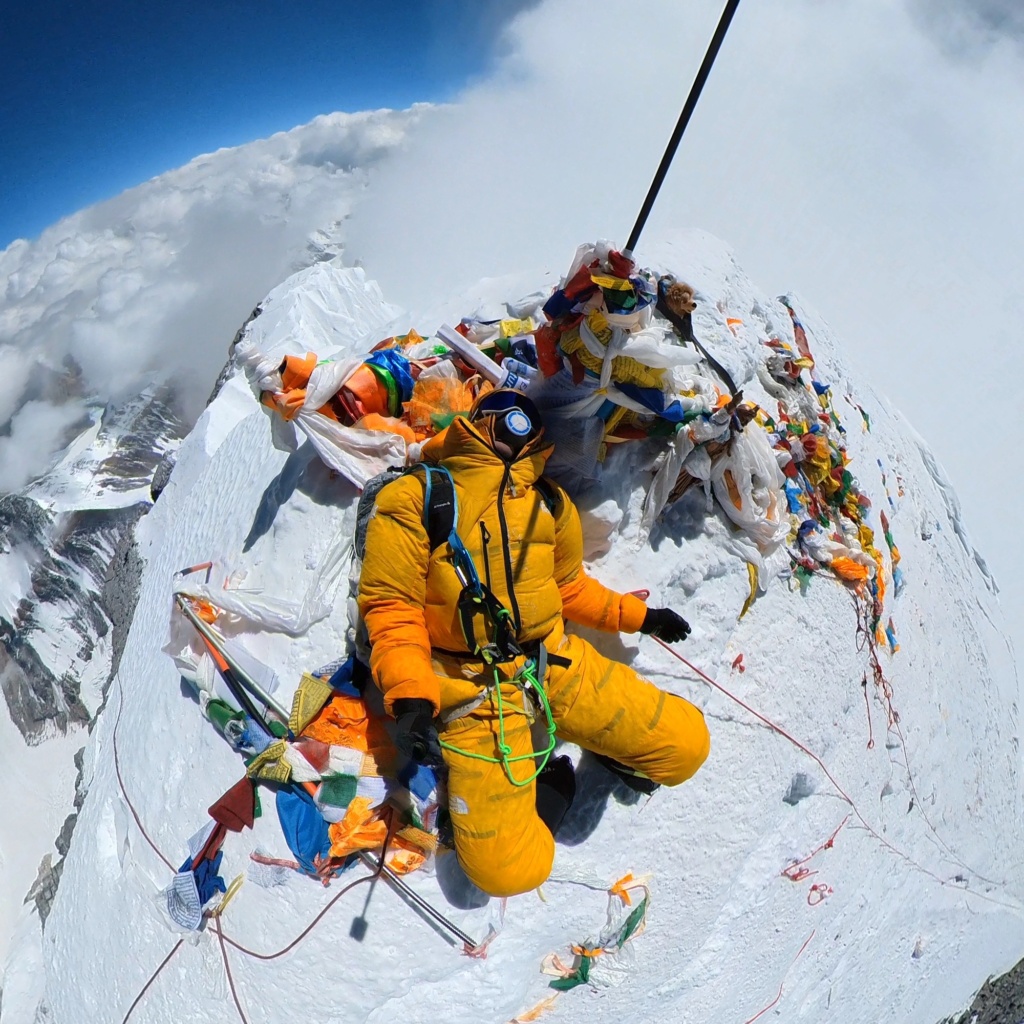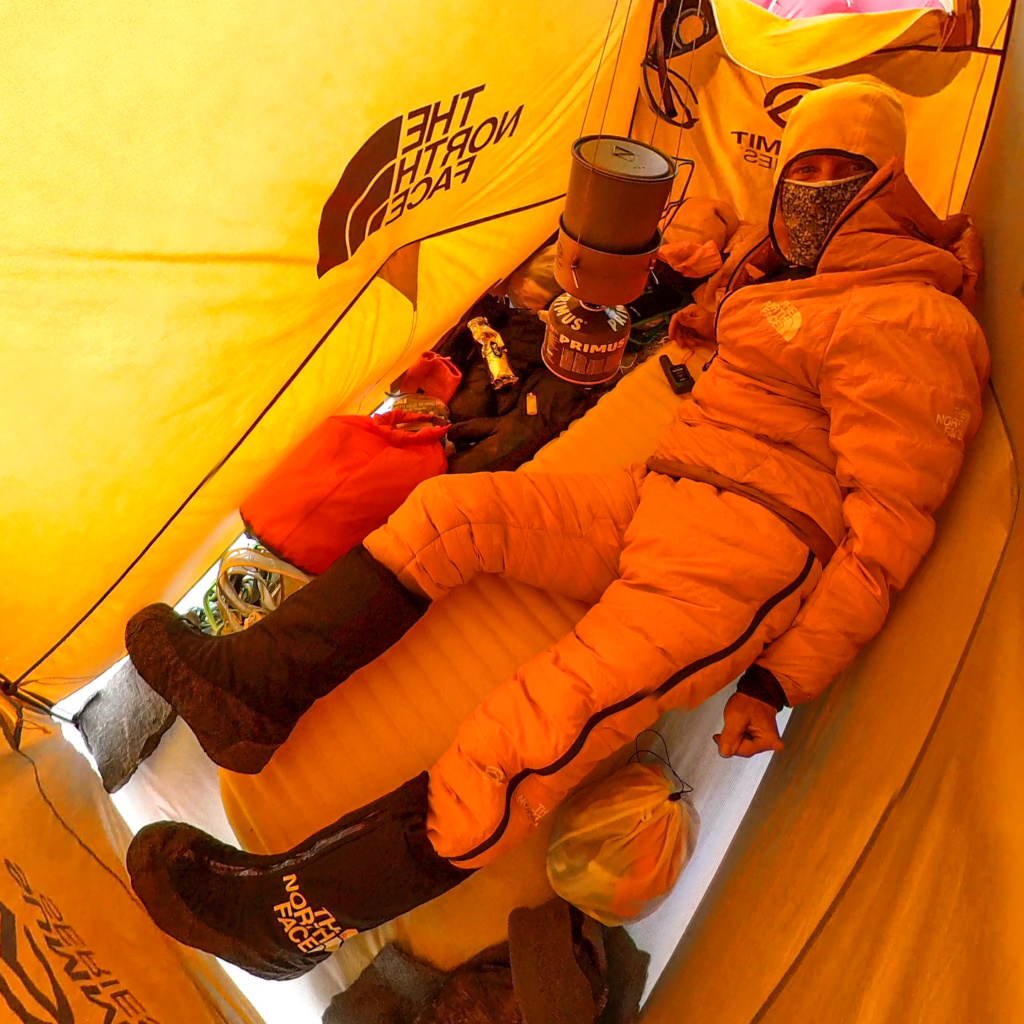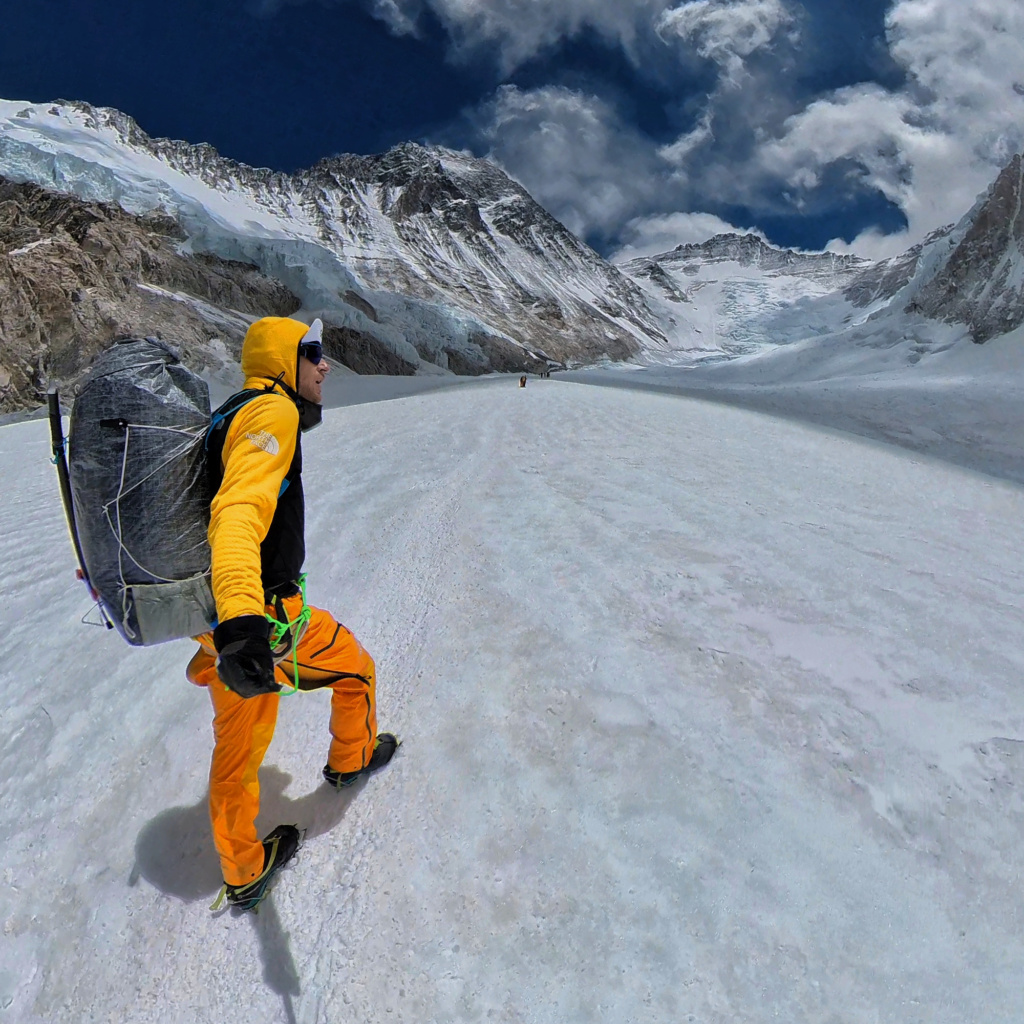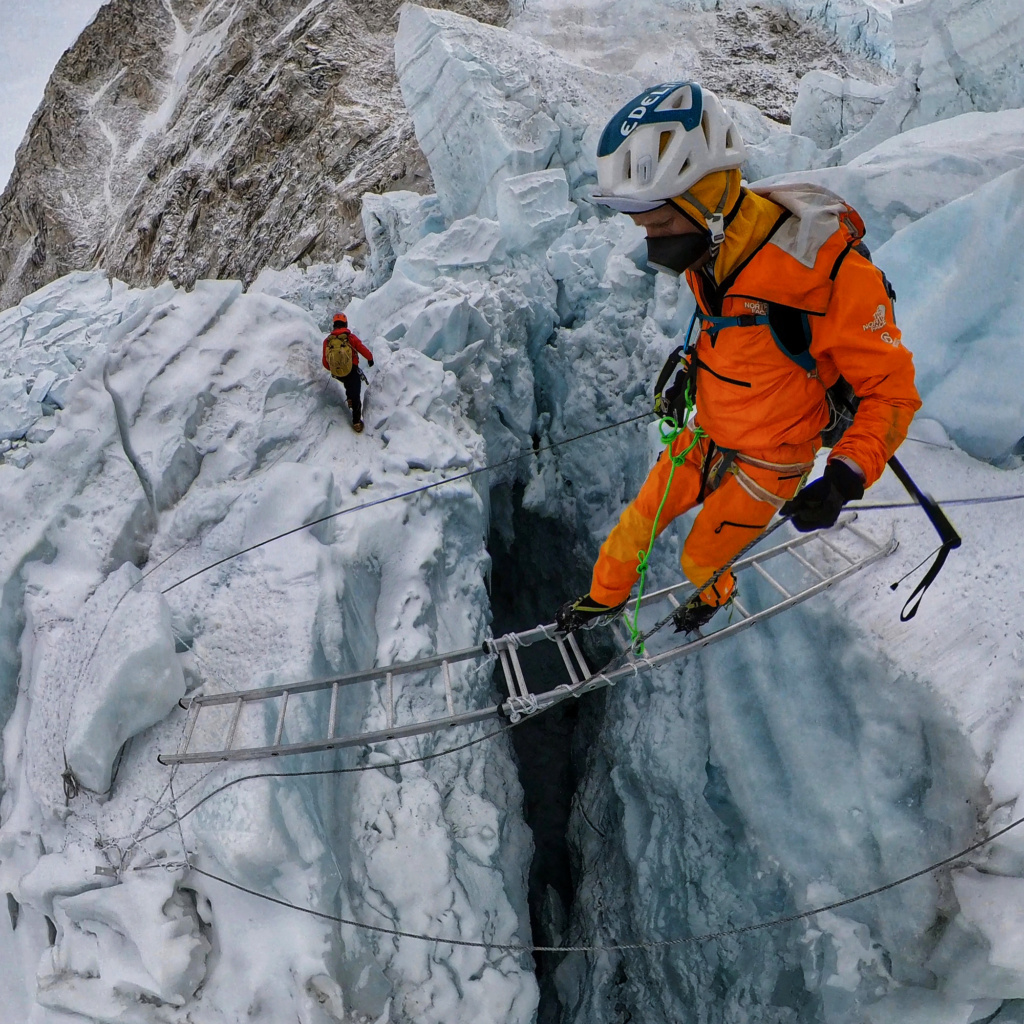On his third attempt, German alpinist David Goettler made a successful climb up Everest, solo and without supplemental oxygen.

First published: https://www.firstpost.com/living/atop-mount-everest-a-german-alpinist-scripts-his-story-without-supplemental-oxygen-or-high-altitude-guide-10838091.html
Atop Mount Everest, a German alpinist scripts his story without supplemental oxygen and high altitude guide
David Göttler is a conqueror of Mount Everest but the ace climber had to turn around on multiple occasions while climbing 8,000ers such as Everest, Nanga Parbat and Shishapangma
On 23 May, 2019, David Göttler set off for the summit of Everest (8,848m) from Camp 4 at 2.30 am. Just above the South Summit (8,750m), the German alpinist saw a line of climbers making gradual upward progress. While most of them had the luxury of breathing supplemental oxygen, Göttler was making an oxygen-less attempt and without any high-altitude guide by his side.
Göttler took a moment to analyse the situation. He realised it was too much of a risk to wait it out in the queue while in the death zone. In that moment, Göttler simply turned around and gave up on his summit aspirations.
Then last year, he was back on Everest, this time with Spanish trail runner, Kilian Jornet. The duo climbed together and without oxygen. Once they arrived at South Col (8,000m), their collective experience at altitude told them something was amiss. Instead of risking trouble higher up, they decided to turn around.
Then this year in May, Göttler made his third attempt on Everest. In the wee hours of 21 May, he found himself all alone beyond the South Summit. He pushed on and finally reached the top at 9.45 am before making a rapid descent off the mountain.

“It was really magical to be climbing alone after what I had experienced in the past. There was no wind, the sun was shining and I had the summit all to myself,” Göttler, 44, says.
In these times of commercial climbing that draws hundreds of aspirants to Everest each spring – around 650 climbers made the summit from the Nepal side this season – Göttler’s success stands out from the rest for his style of climbing. Since the time he started out at the age of seven under the watchful eye of father, Ernesto, he’s been a proponent of the light and fast approach, without the use of supplemental oxygen or a high altitude guide. It’s often meant returning home empty-handed, but he’s stayed true to what he had learnt since his early climbing days.
“I chose to move in the mountains in a self-sufficient way and progressed slowly over the years to get to where I am today. I’ve always been a part of small teams, which means there is no scope of carrying big, heavy equipment. This is what eventually defined my ethics and my style of climbing,” Göttler says.
In 2006, Göttler got to the summit of Gasherbrum II – his first 8,000 metre mountain. Since then, he’s gone on to climb five more of these giants that culminated in Everest this year. But what most are unaware of is that over the years, he’s had to turn around on multiple occasions while climbing 8,000ers such as Everest, Nanga Parbat and Shishapangma.
“It’s never easy and you feel a lot of frustration and disappointment. But in that moment, it’s not a difficult decision to turn around because I always try to anticipate what can happen. Success is not just about reaching the summit – it’s also when you can manage to call off the climb at the right point and don’t need to be rescued. I think real success is only when you come back without frostbites and traumas. It’s tricky but this is what it’s about for me,” he says.

“For instance, there were those who summited various mountains this spring, but got into trouble on their way down. Clearly, something went really wrong for them to have frostbites. I’m heartbroken for these guys and what they’ve had to suffer. But I just cannot call this success,” he adds.
After arriving in the Solu-Khumbu region in Nepal, Göttler’s first acclimatisation rotation took him to Mera Peak (6,476m), where he slept a night on the summit, “away from the Everest circus”. Then he pulled off three rotations on Everest before the summit push, where his high point took him to the top of the Geneva Spur (7,900m). In all, he spent a night at Camp 3 and five at Camp 2 as part of his acclimatisation on the mountain.
He says the ropes to the top of Everest were set up as early as 7 May, which in turn benefitted his own attempt. Good weather there on meant that a lot of the other climbers made their final summit push while he was still on his acclimatisation rounds. It eventually left the mountain uncrowded when he decided to go for the top. However, the decision to be patient and wait it out was anything but easy.
“When you pass so many people going for the summit, it plays on your mind and it’s difficult not to get drawn into it. All kinds of thoughts run through your head – will the weather still be as nice when I’m ready for my summit attempt? After the two cyclones last year, I was quite aware of how things can change on Everest. You don’t want to be the king of acclimatisation and never get to the summit!” he says, chuckling.
At 9.30 pm on 20 May he set off from Camp 4 on the South Col. His load was light – a litre of water, three energy bars, two gels and a spare pair of gloves. It took him 12 hours 20 minutes to get to the summit of Everest and another five hours to get back to camp.
“The mental challenge on these mountains is way harder than the physical aspect of climbing. And over the years, I’ve learnt that I don’t really have to look at what other people are doing. Because 98 per cent of them are going with oxygen and Sherpas, so it’s very different from what I do,” he says.

That said, there’s always the risk of getting into trouble on the mountain. Göttler usually chooses to go with a partner to bring more safety to his climbs and exchange ideas before arriving at major decisions. But on Everest, he took the call to go solo, the only backup in the form of a device through which he could text his girlfriend back home in Spain.
“I usually like to share these experiences with someone. But for the first time, I had this feeling of being in a flow state on the mountain. I enjoyed the freedom of making decisions. I was constantly having a conversation with myself after analysing the terrain and how I felt in the moment. The most important thing is to accept that up on the mountain, you cannot count on someone coming to rescue you because everyone is at their limit and resources are few. So, you just have to ensure that you don’t get into any trouble,” he says.
Göttler also cannot wrap his head around the trend of climbers knocking down multiple big mountains in a single season. And how those with limited experience decide to take on daunting peaks such as Kangchenjunga and Makalu as their first climb up an 8,000er.
“A lot of the summiteers wouldn’t make it to the top if you took away their oxygen. And the moment you use oxygen, you take away the difficulty that nature throws at you. You are actually climbing a 6,000-metre peak or even lower, depending on the flow of oxygen. So there’s a need to distinguish between the different sports that are unfolding on the same 8,000 metre peak,” he says.
“I don’t want to take away from their feat – everybody can choose the climbing style they wish to adopt. But these are mountains that need a lifetime of preparation before you can tackle them. So we need to be clear that it’s no historical sporting feat or any kind of first if one is on bottled oxygen,” he adds.
Even after his success on Everest, Göttler put out a post, clarifying the fact that he did benefit from the fixed rope laid out on the mountain.
“It’s important to be clear about how you made it to the top. There are those who use oxygen and then try to hide their masks in the summit photo. As a community, we need to be honest and transparent about what we do and how we do it,” he says.
These days, Göttler is back at his summer base of Santander in northern Spain. With Everest in his bag, he doesn’t rule out another attempt on the mountain, this time perhaps via a different route.
“Reaching the top made me realise that Everest is a different beast. That said, I’m not the kind of person who just ticks off summits – the route and style is very important to me. Now I know the mountain even better, so this gives me the knowledge and advantage of perhaps taking on a different challenge on Everest in the time ahead,” Göttler says.